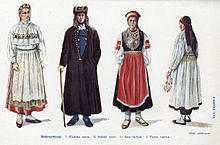Estonians
The Estonians (Estonian eestlased ) are an autochthonous northern European Finno-Ugric ethnic group with around one million members. They form the titular nation of Estonia .
Ethnically, the Estonians do not belong to the Balts , but, together with the Hungarians and Finns, to the Finno-Ugric peoples. Geographically, however, Estonia is in the Baltic States.
Surname
The original name of the Estonians was maarahvas . This is possibly a loan translation of the German word Landvolk , which in the Middle Ages simply meant "native".
It was not until the 18th century that the name eestlane was added. This was possibly influenced by the name of the Baltic estuary in the western Baltic . Both groups are not identical.
In Old Russian chronicles the term Tschuden was used for the inhabitants of Estonia.
history
Early history
As with all peoples without written records, not much is known about the ethnogenesis and early history of the Estonians.
A biological relationship with the Volga Finns or Permyaks ( Komi and Udmurten ) seems unlikely in view of their little similarity. The peoples of the Arctic Coast from the Nenets in the east to the Sami in the west have a similar culture, determined by the climatic conditions.
The first written account of the Baltic comes from the Roman historian Tacitus . In 98 he reported in his Germania about the Aestii . This was the name the Teutons gave to the inhabitants northeast of the Vistula . Tacitus described the "tribes of the Aestians who have the customs and dress of the Suebi " , but whose language is closer to the British . However, this name originally referred to a Baltic tribe, the Aists, who lived on the Prussian Baltic coast, and in ancient times served as a collective name for all Baltic people.
At the time of the Ostrogothic rule in Italy in the first half of the 6th century, Cassiodorus reports of an Estonian embassy at the court in Ravenna .
Time of foreign rule
In the 13th century, the Estonians in southern Livonia were subjected to the German-Baltic nobility and forced to become Christianized by knights of the Teutonic Order during the Lithuanian Wars . Two fundamentally different classes of population developed: the native, Estonian rural population and the immigrant German ruling class. Even after the order's territory collapsed, the Privilegium Sigismundi Augusti, issued in 1561, guaranteed the estates the right to use the German language, German jurisdiction and the Protestant faith . The German language remained the main lingua franca of the upper classes until the 20th century. Every Estonian who wanted to achieve social advancement was forced to make extensive adjustments. The Imperial University of Dorpat (Tartu) was a German university from 1802 to 1880, both intellectually and in terms of teaching staff.
National Awakening Time
It was not until the middle of the 19th century that a feeling of togetherness emerged among the Estonians and led to the awakening of Estonian national consciousness. However, many Estophile Baltic Germans, such as Garlieb Helwig Merkel , also played a decisive role in the development of Estonian national consciousness . The national movement was directed against the tutelage and privilege of the Baltic Germans and the Russification emanating from the Tsarist Empire with the introduction of the Russian language as the official and teaching language. A rapidly growing national consciousness developed between these poles, but it was not until 1918 that the Estonians were able to achieve their independence.
World War II and regaining independence
The Second World War ended the independence it had just gained and resulted in Estonia's population being reduced by 200,000. In the 1940s, tens of thousands of Estonians died as a result of war, terror and occupation by the Soviet Union and the German Reich . The balance includes 30,000 fallen Estonians. Around 1,000 Estonians of Jewish origin were murdered in the Holocaust . After the war, the number of Estonians in their own country decreased again by 80,000 people, who fled for fear of a new wave of terror in the Soviet Union. The occupation of the country, which lasted until 1991, resulted in not only 70,000 Estonians suffering from reprisals , of whom 12,000 were killed. As part of a comprehensive Russification policy , Russians , Ukrainians and Belarusians were forced to settle , as a result of which the percentage of Estonians within the Estonian SSR fell from around 90% at the end of the war to 60% at the end of the 1980s.
Development tendencies
Even after regaining sovereignty , around 25% of the population of the Republic of Estonia is Russian-speaking. As before, there is hardly any mixing of the two population groups. Of the considerable number of foreigners living in Russia, 40,000 live, many of them in the Setumaa region, which has long been disputed between the two countries .
language
The Estonian language belongs to the Finno-Ugric language family and is the official language of the Republic of Estonia . It is spoken by around 1,000,000 people in Estonia and tens of thousands more Estonians worldwide.
See also
Web links
Individual evidence
- ↑ so Beyer, Jürgen: Is maarahvas ('country folk'), the old self-designation of the Estonians, a loan translation? A study on the conceptual history of the Baltic Sea region. , In: Journal for East Central Europe Research 56 (2007), pp. 566-593.
- ↑ 45. The esters and the amber .
- ↑ Keyword Aisten in the Reallexikon der Germanischen Altertumskunde, Walter de Gruyter, 2000, p. 116 ff. Online
- ↑ Cassiodorus: Variae . No. 5.2 .
- ↑ Excerpt from: Benedict Hasenstab, Studien zur Variensammlung Des Cassiodorius Senator, Volume 1, p. 23
- ↑ Burkhard Asmuss (Ed.): Holocaust. The National Socialist Genocide and the Motives of its Memory . German Historical Museum. Berlin 2002, ISBN 3-932353-60-9 .
- ^ Laar, Mart: Estonia in World War II. Tallinn 2005.
- ↑ Laar, Mart: Foray through Estonian history. Tallinn 2005.
